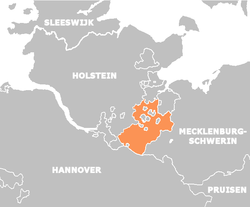Saxe-Lauenburg
| Duchy of Saxe-Lauenburg | ||||||||||
| Herzogtum Sachsen-Lauenburg | ||||||||||
|
State of the Holy Roman Empire State of the German Confederation State of the North German Confederation State of the German Empire |
||||||||||
|
||||||||||
|
||||||||||
|
Saxe-Lauenburg in 1848 (map in Dutch)
|
||||||||||
| Capital |
Lauenburg/Elbe Ratzeburg (from 1619) |
|||||||||
| Government | Principality | |||||||||
| Historical era | Middle Ages | |||||||||
| • | Partitioned from Duchy of Saxony | 1296 | ||||||||
| • | Partitioned into Saxe-Mölln-Bergedorf and Saxe-Ratzeburg |
1303–1401 |
||||||||
| • |
Personal union: - with Lüneburg-Celle - with Hanover |
1689–1705 1705–1803 |
||||||||
| • | Dissolved during Napoleonic Wars |
1803–1814 |
||||||||
| • | Personal union: - with Denmark - with Prussia |
1814–1864 1865–1876 |
||||||||
| • | Merged into Prussia | 1876 | ||||||||
|
||||||||||
The Duchy of Saxe-Lauenburg (German: Herzogtum Sachsen-Lauenburg, called Niedersachsen (Lower Saxony) between the 14th and 17th centuries), was a reichsfrei duchy that existed 1296–1803 and 1814–1876 in the extreme southeast region of what is now Schleswig-Holstein. Its territorial center was in the modern district of Herzogtum Lauenburg and originally its eponymous capital was Lauenburg upon Elbe, though in 1619 the capital moved to Ratzeburg.
In addition to the core territories in the modern district of Lauenburg, at times other territories, mostly south of the river Elbe, belonged to the duchy:
In 1203, King Valdemar II of Denmark conquered the area later comprising Saxe-Lauenburg, but it reverted to Albert I, Duke of Saxony in 1227. In 1260, Albert I's sons Albert II and John I succeeded their father. In 1269, 1272 and 1282, the brothers gradually divided their governing competences within the three territorially unconnected Saxon areas along the Elbe river (one called Land of Hadeln, another around Lauenburg upon Elbe and the third around Wittenberg upon Elbe), thus preparing a partition.
After John I's resignation, Albert II ruled with his minor nephews Albert III, Eric I and John II, who by 1296 definitely partitioned Saxony providing Saxe-Lauenburg for the brothers, and Saxe-Wittenberg for their uncle Albert II. The last document, mentioning the brothers and their uncle Albert II as Saxon fellow dukes dates back to 1295. A deed of 20 September 1296, mentions the Vierlande, Sadelbande (Land of Lauenburg), the Land of Ratzeburg, the Land of Darzing (later Amt Neuhaus), and the Land of Hadeln as the separate territory of the brothers.
...
Wikipedia



